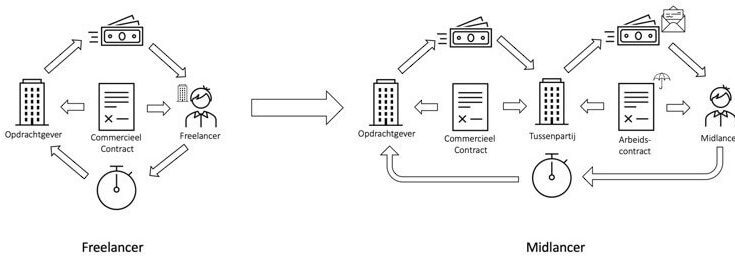Working as a midlancer, what does that actually mean? In the freelance world, this buzzword is popping up more and more. Where does this term come from, and does it resemble freelancing? We went on an investigation. Find out everything you need to know about midlancing below!
What is a midlancer?
The term “midlancer” has been around since 1995, and was created by the founders of The Human Network. At THN, they came up with a model that combined the benefits of working as an employee with the benefits of freelancing.
Midlancing is often compared to the system of flexi-jobs. As a midlancer, you work independently, but you are tied to a midlance agency. This means that you are not self-employed, but have the status of an employee. The advantage of midlancing is that you get many different assignments to work on. This makes your job very varied.
For companies working with midlancers, there is almost no difference.
The difference between a Midlancer and Freelancer?
Midlancing and freelancing are very similar, but there are some differences.
Here are some of the biggest differences:
1) You are employed by a company
Those who freelance have an independent status. Midlancers are employed by a company. This means that as a midlancer, you get a fixed salary. This is not the case with freelancers, who are financially dependent on the assignments they receive.
2) More security as a midlancer
A big advantage of working as a midlancer is that you can still enjoy all the social and commercial protection of a salaried staff member.
If you are a midlancer and can’t work due to illness, or if you aren’t able to go to work for a while, you will receive your salary just like any wage earner.
Freelancers do not have that luxury. They are only paid for the hours they work. If they cannot work, they earn nothing.
Therefore, as a freelancer, it is very important to save a reserve. Most freelancers also have a Guaranteed Income insurance. This insurance ensures that if you become disabled as a freelancer, you will still receive an income.
3) No paperwork
Midlancers are connected to a midlance agency. This has its advantages, as the agency acts as an intermediary between the client and the midlancer.
The agency takes care of payrolling, contracts… As a midlancer you only have to deal with your work, and not with all kinds of paperwork.
A big additional advantage is that midlance agencies can help you find assignments. Such agencies often have a large network, so as a midlancer you are rarely without work.

4) Less freedom from pay
As a freelancer, you have the freedom to determine your own salary. If you get an assignment that requires more time and preparation, you can choose to increase your hourly rate.
As a midlancer, you do not have this freedom, you work at a monthly wage. Midlancers can of course negotiate with the midlancy agency that employs them about their wages, but the decision still depends on the employer.
At the moment, midlancing is on the rise, especially in the Netherlands. There are already several midlance agencies in our northern neighborhood. This is not yet the case in Belgium.
Midlancing: for whom?
Are you someone who is hesitant to start working as a freelancer? Then midlancing might be for you. Midlancing gives you a taste of the entrepreneurship of freelancing. For many aspiring freelancers, it can be a stepping stone to a new career.
Are you already convinced and are you sure you want to work as a freelancer? Then we do not recommend midlancing. For the same assignments, you will earn more as a freelancer than when you work as a midlancer. As a freelancer, you are also much more independent, you are after all your own boss.




